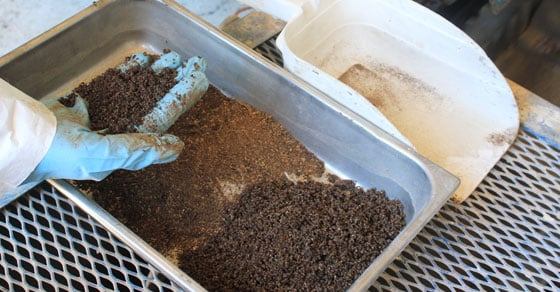The transformation of organic wastes into premium fertilizer products is becoming increasingly popular. In turn, expansive research and development is being done around the processing of these wastes. This is particularly true in the agriculture industry where various types of manure are being processed into premium fertilizer products, creating a revenue stream where once waste disposal costs were incurred.
However, the processing of manure into a granular product is not a well-established industry. And with significant variation between manure types and even amongst the same type of manure, thorough testing is the foundation to creating a process that produces a uniform end product that meets the desired specifications.
Why Granulate Manure?
The granulation of manure into a dry fertilizer product has seen near exponential interest in recent years, because of the many benefits it provides, both to the farmer or livestock manager, and to the environment. A summary of the benefits includes:
- Dry granules can be stored and used as needed, unlike raw manure, which must be used immediately.
- Dry granules are odor-free, and significantly easier to handle and apply, even opening up opportunities in precision agriculture.
- The opportunity for nutrient runoff is reduced, because granules make it easier to follow a nutrient management program, and do not add moisture to the soil, which can increase the opportunity for runoff
- Custom fertilizer products can be created, offering improved crop nutrient management, and generating an additional source of revenue for the farmer.
- Transportation costs are greatly reduced.
- Unlike raw manure, nutrient content does not vary and therefore results are reliable and consistent.
Various types of manure can be converted into dry, granular fertilizer products to improve handling and application, as well as on-farm crop nutrient management. Types of manure that are commonly converted into organic-based fertilizers and fortified NPK blends include:
- Chicken Manure
- Chicken Litter
- Turkey Manure
- Turkey Litter
- Cattle Manure
- Dairy Manure
- Hog Slurry
Why Testing is Important
When working with organics, testing is critical to the development of the process itself, as well as the overall success of the process and product.
In addition to variation in the type of manure, many on-farm practices can affect the make-up of the manure. The type of feed the animals consume, the type of separation system, handling practices, farm location, and even barn type can all change the consistency and make-up of the manure, creating an unending matrix of manure outcome possibilities and making testing an absolute necessity.
How Testing Works
As with any testing, the manure sample must be as representative as possible, to ensure the testing process simulates on-farm conditions.
The first objective is to determine if a pre-conditioning step is needed. In order for granulation to occur successfully, the material must meet certain criteria, and may require a pre-conditioning stage to prepare the material before granulation can begin.
Depending on the consistency and make-up of the manure, a variety of pre-conditioning methods are available, including solid/liquid separation, pre-drying, grinding, composting, digestion, or a combination of methods.
The main factors that influence the success of a granulation process include:
Particle Size Distribution: While the ideal particle size distribution is different depending on the type of manure, in general, a feedstock particle size of around 60 mesh is desirable. Large chunks will require size reduction. If the material contains fibers from bedding, for example, it will likely require a grinding step in order to create a more uniform particle size distribution.
Moisture Content: The material must fall within a set window of moisture for granulation to be possible. This varies depending on the type of manure, with dairy and hog manure needing a moisture content between 60% to 80%, and poultry manure between 20% to 30%. This allows for a material that is dry enough that it can still accept moisture, but wet enough that it is tacky and capable of picking up particles.
Material Composition: The composition of the material will also affect granulation. For example, if the feedstock does not contain natural binding agents, then one would need to be added, or the granules would be too weak. Or, if the feedstock is made up of coarse fibers, granulation will be difficult. Furthermore, if a bedding is included, the nutrient content may be diluted.
All of these things will change how the material will respond to agglomeration, and consequently, how the process will need to be designed in order to produce the desired results. It may be obvious from the start whether a material will require pre-processing, or this conclusion may be reached through the testing process itself.
While there are two general approaches to granulating manure (mixer-dryer and mixer-pelletizer-dryer), with so much variation in material, it is often not clear which method will best suit the material and be able to produce the desired end product results. Since the mixer-dryer method is the less complex of the two, testing often begins here. The consistency of the material most often dictates which mixer will be the most suitable starting point, with pin mixers favoring more dry, finely divided solids such as chicken litter, and paddle mixers more suited to cakes and slurries such as separated dairy manure.
Mixer to Dryer: How it Works
In this approach, the material is first agglomerated with a binder in a pin or paddle mixer, producing oblong pellets. The pellets are carried via conveyor to a rotary dryer, where the moisture content is reduced to produce the final, dry pellet product.
If this method produces the desired results, process experts can move on to fine-tuning the process, and testing it as a continuous process loop.
However, if the end product requires more refinement, or if the process is struggling to produce on-size product, process experts will likely try another approach, either utilizing a different mixer, or adding a disc pelletizer to the process.
Mixer to Pelletizer to Dryer: How it Works
The mixer to pelletizer to dryer approach is similar to the first method, but with an added layer of control.
The addition of a disc pelletizer allows process experts to more closely control and fine-tune the size and other characteristics of the end product.
In this process, the mixer serves the purpose of creating a uniform mixture of raw material and binder (and recycle when applicable). A homogeneous mixture is created and “seed pellets” are formed. The seed pellets are then fed onto the disc pelletizer, where they can be further rounded and “grown” to the desired size. Round pellets then exit the disc and are carried via a conveyor to the dryer.
Product Customization
Most often, producers are looking to target a specific set of particle characteristics, which could be any combination of the following:
- Bulk Density
- Crush Strength
- Solubility
- Attrition
- Compression
- Particle Size Distribution
- Flowability
- Moisture Content
- Physical/Surface Quality
- Green/Wet Strength
Testing centers around the creation of these desired product specifications. Throughout testing, process experts work with a number of variables in order to produce these results. Depending on the setup, variables may include:
- Material Feed Rate
- Amount of Recycle
- Binder Feed Rate
- Type of Binder
- Mixer Speed
- Type of Mixer
- Mixer Pin/Paddle Arrangement
- Disc Speed
- Disc Angle
- Dryer Temperature
- Dryer Air Flow (Co-Current or Counter Current)
- Dryer Flight Design and/or Pattern
It’s important to note that while the product created can be 100% manure based, the granulation process also accommodates the addition of other value-adding materials. Additional macro- or micro-nutrients can be added to improve overall quality and create a fortified nutrient blend customized to a desired application.
The Phases of Testing
The organics testing process generally happens in four phases:
- Feasibility/Proof of Product: Process experts run batch scale tests to determine if the product will agglomerate. Small sample sizes can be produced for use in lab or grow room trials to determine if the product will perform as needed.
- Proof of Concept: In this more in-depth testing phase, more time is spent determining if the product can be made to exact specifications.
- Proof of Process: Building off of step two, this phase utilizes a continuous setup to determine if the process is viable on a continuous scale, and what process variables will need to look like to result in a successful product.
- Process/Product Optimization: This phase works on fine-tuning the end product, as well as the process itself, providing a recipe for process scale-up.
Conclusion
The transformation of many types of manure into premium fertilizer products offers substantial benefits, both economically and environmentally. However, the road to a successful organics granulation process is rife with trial and error, with many factors influencing the success of the end product and the overall process. A comprehensive testing program is the foundation of a successful organics granulation operation.
FEECO has been helping companies around the world to transform their organic wastes into value-added, premium fertilizer products since 1951. Our unique Innovation Center offers customized testing programs to help you turn your idea into a full-scale, realized process. For more information on testing in the FEECO Innovation Center, contact us today.



